Abstract
A controlled trial of elective intervention with continuous positive airway pressure (CPAP) was performed on 24 infants with hyaline membrane disease whose arterial oxygen tension (Pao2) fell below 8kPa (60 mmHg) while they were breathing a fractional inspired oxygen concentration (F1O2) greater than 0.60. A face mask was used to apply the CPAP. The progress of the 12 infants who were treated on entry to the trial was compared with that of 12 infants who were treated later. All 12 infants in the early-intervention group and 8 infants in the late-intervention group survived. When CPAP was started, Pao2 increased and the early-treated infants breathed high concentrations of oxygen for a shorter period than the late-treated infants. The 4 infants in the early-intervention group who required mechanical ventilation needed lower mean airway pressures to achieve satisfactory gas exchange than the 7 ventilated infants in the late-intervention group. We conclude that a Pao2 less than 8 kPa while breathing an F1o2 greater than 0.60 is an adequate indication for giving CPAP in hyaline membrane disease, and that early intervention with CPAP allows infants who go on to require mechanical ventilation to be ventilated at lower pressures.
Full text
PDF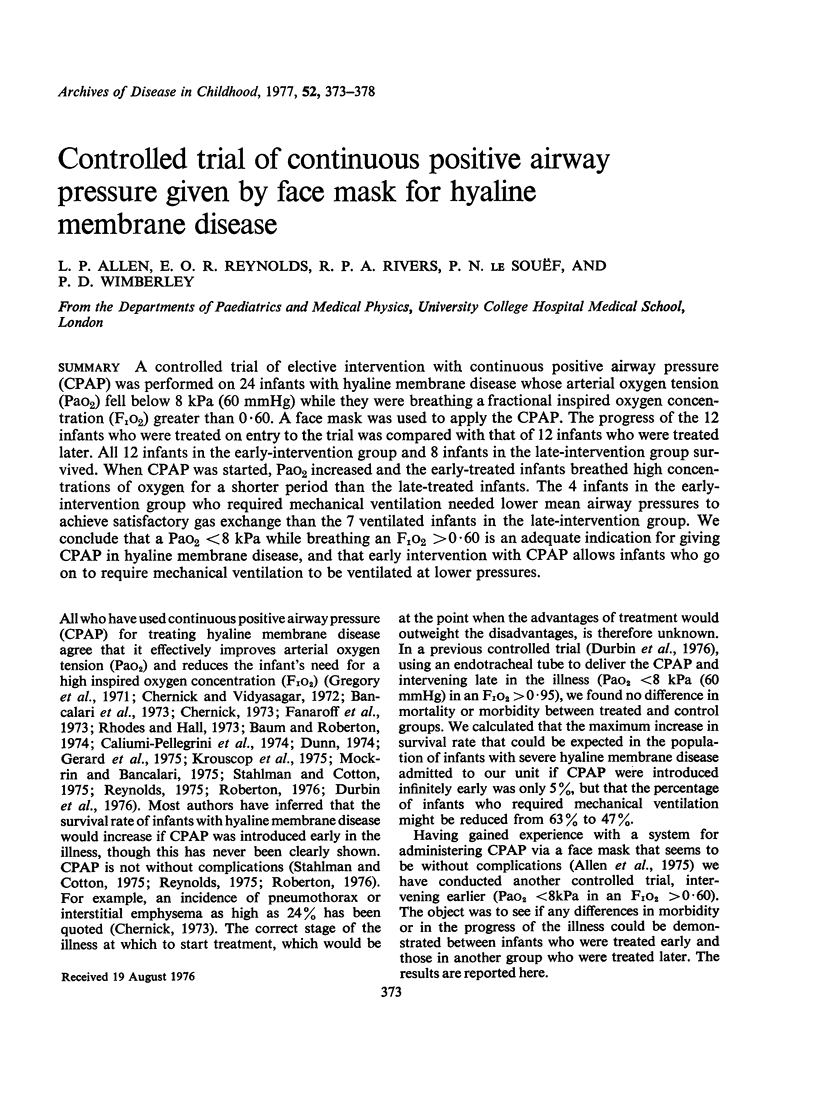
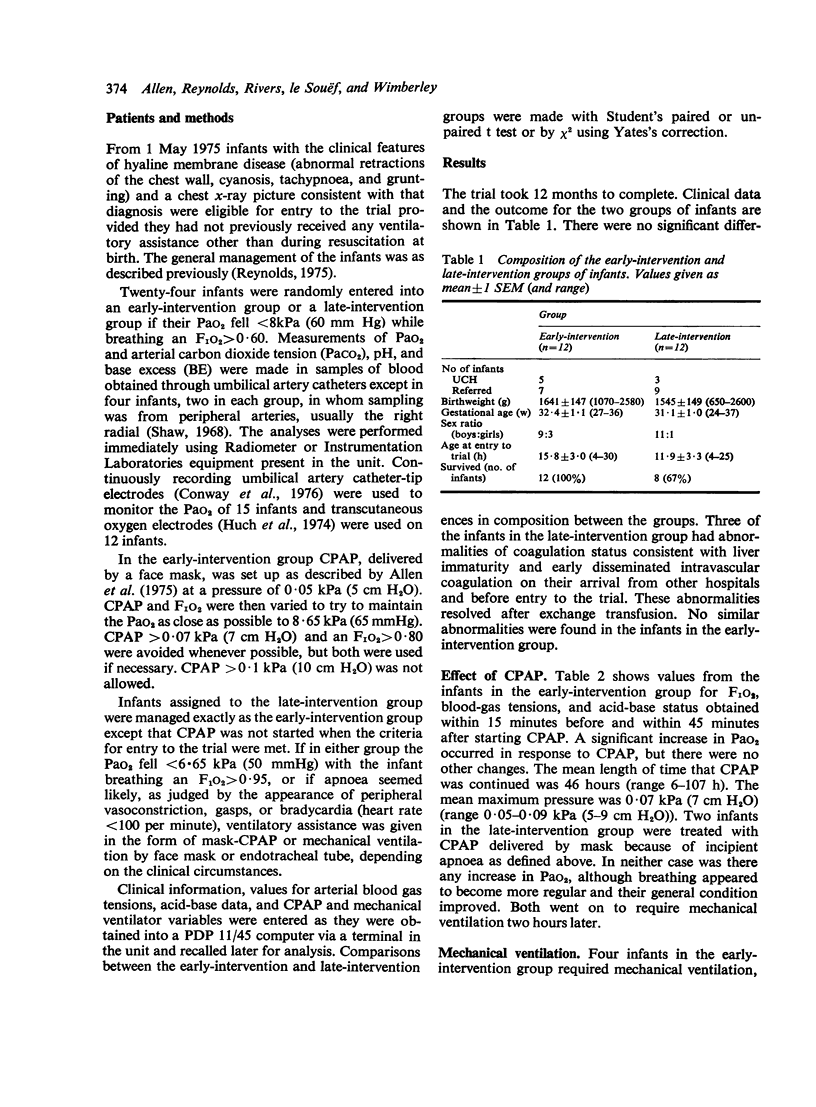
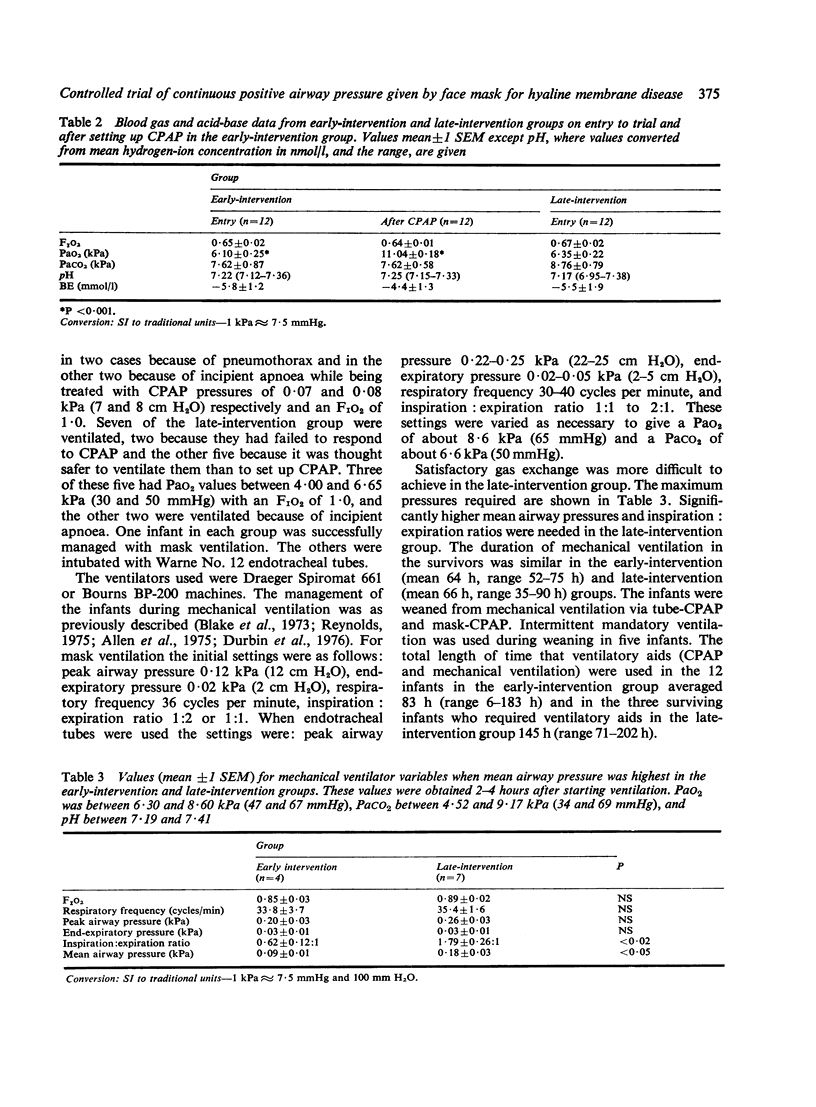
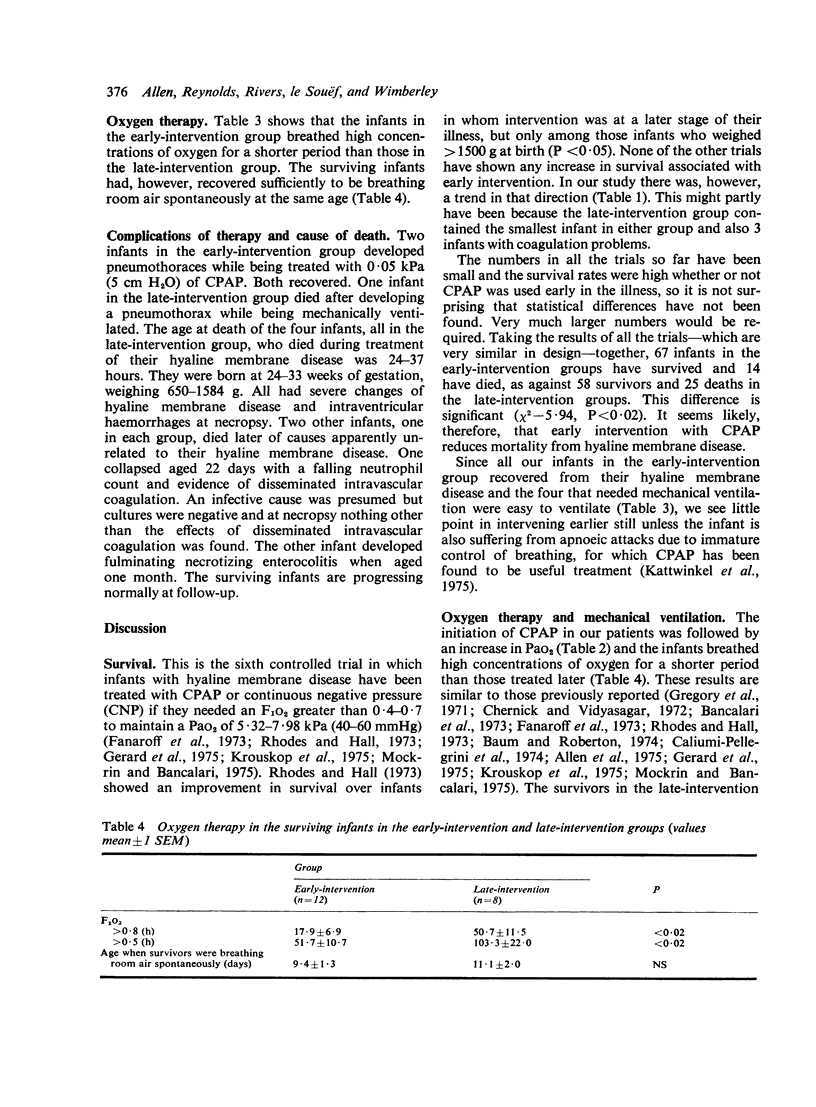
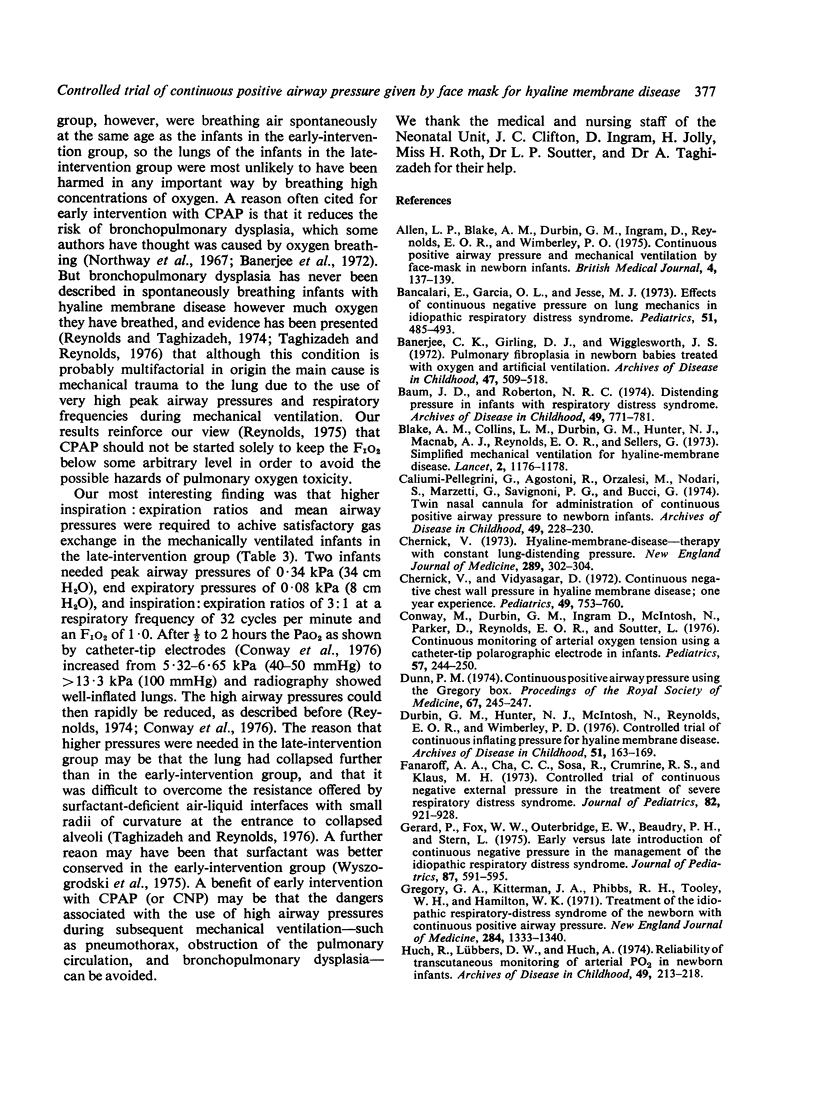

Selected References
These references are in PubMed. This may not be the complete list of references from this article.
- Allen L. P., Blake A. M., Durbin G. M., Ingram D., Reynolds E. O., Wimberley P. D. Continuous positive airway pressure and mechanical ventilation by facemask in newborn infants. Br Med J. 1975 Oct 18;4(5989):137–139. doi: 10.1136/bmj.4.5989.137. [DOI] [PMC free article] [PubMed] [Google Scholar]
- Bancalari E., Garcia O. L., Jesse M. J. Effects of continuous negative pressure on lung mechanics in idiopathic respiratory distress syndrome. Pediatrics. 1973 Mar;51(3):485–493. [PubMed] [Google Scholar]
- Banerjee C. K., Girling D. J., Wigglesworth J. S. Pulmonary fibroplasia in newborn babies treated with oxygen and artificial ventilation. Arch Dis Child. 1972 Aug;47(254):509–518. doi: 10.1136/adc.47.254.509. [DOI] [PMC free article] [PubMed] [Google Scholar]
- Baum J. D., Roberton N. R. Distending pressure in infants with respiratory distress syndrome. Arch Dis Child. 1974 Oct;49(10):771–781. doi: 10.1136/adc.49.10.771. [DOI] [PMC free article] [PubMed] [Google Scholar]
- Blake A. M., Durbin G. M., MacNab A. J., Collins L. M., Hunter N. J., Reynolds E. O., Sellens G. Simplified mechanical ventilation for hyaline-membrane disease. Lancet. 1973 Nov 24;2(7839):1176–1178. doi: 10.1016/s0140-6736(73)92941-3. [DOI] [PubMed] [Google Scholar]
- Caliumi-Pellegrini G., Agostino R., Orzalesi M., Nodari S., Marzetti G., Savignoni P. G., Bucci G. Twin nasal cannula for administration of continuous positive airway pressure to newborn infants. Arch Dis Child. 1974 Mar;49(3):228–230. doi: 10.1136/adc.49.3.228. [DOI] [PMC free article] [PubMed] [Google Scholar]
- Chernick V. Hyaline-membrane disease: therapy with constant lung-distending pressure. N Engl J Med. 1973 Aug 9;289(6):302–304. doi: 10.1056/NEJM197308092890606. [DOI] [PubMed] [Google Scholar]
- Chernick V., Vidyasagar D. Continuous negative chest wall pressure in hyaline membrane disease: one year experience. Pediatrics. 1972 May;49(5):753–760. [PubMed] [Google Scholar]
- Conway M., Durbin G. M., Ingram D., McIntosh N., Parker D., Reynolds E. O., Soutter L. P. Continuous monitoring of arterial oxygen tension using a catheter-tip polarographic electrode in infants. Pediatrics. 1976 Feb;57(2):244–250. [PubMed] [Google Scholar]
- Dunn P. M. Respiratory distress syndrome. Continuous positive airway pressure (CPAP) using the Gregory box. Proc R Soc Med. 1974 Apr;67(4):245–247. [PMC free article] [PubMed] [Google Scholar]
- Durbin G. M., Hunter N. J., McIntosh N., Reynolds E. O., Wimberley P. D. Controlled trial of continuous inflating pressure for hyaline membrane disease. Arch Dis Child. 1976 Mar;51(3):163–169. doi: 10.1136/adc.51.3.163. [DOI] [PMC free article] [PubMed] [Google Scholar]
- Fanaroff A. A., Cha C. C., Sosa R., Crumrine R. S., Klaus M. H. Controlled trial of continuous negative external pressure in the treatment of severe respiratory distress syndrome. J Pediatr. 1973 Jun;82(6):921–928. doi: 10.1016/s0022-3476(73)80418-4. [DOI] [PubMed] [Google Scholar]
- Gerard P., Fox W. W., Outerbridge E. W., Beaudry P. H. Early versus late introduction of continuous negative pressure in the management of the idiopathic respiratory distress syndrome. J Pediatr. 1975 Oct;87(4):591–595. doi: 10.1016/s0022-3476(75)80832-8. [DOI] [PubMed] [Google Scholar]
- Gregory G. A., Kitterman J. A., Phibbs R. H., Tooley W. H., Hamilton W. K. Treatment of the idiopathic respiratory-distress syndrome with continuous positive airway pressure. N Engl J Med. 1971 Jun 17;284(24):1333–1340. doi: 10.1056/NEJM197106172842401. [DOI] [PubMed] [Google Scholar]
- Huch R., Lübbers W., Huch A. Reliability of transcutaneous monitoring of arterial PO2 in newborn infants. Arch Dis Child. 1974 Mar;49(3):213–218. doi: 10.1136/adc.49.3.213. [DOI] [PMC free article] [PubMed] [Google Scholar]
- Kattwinkel J., Nearman H. S., Fanaroff A. A., Katona P. G., Klaus M. H. Apnea of prematurity. Comparative therapeutic effects of cutaneous stimulation and nasal continuous positive airway pressure. J Pediatr. 1975 Apr;86(4):588–592. doi: 10.1016/s0022-3476(75)80158-2. [DOI] [PubMed] [Google Scholar]
- Krouskop R. W., Brown E. G., Sweet A. Y. The early use of continuous positive airway pressure in the treatment of idiopathic respiratory distress syndrome. J Pediatr. 1975 Aug;87(2):263–267. doi: 10.1016/s0022-3476(75)80599-3. [DOI] [PubMed] [Google Scholar]
- Mockrin L. D., Bancalari E. H. Early versus delayed initiation of continuous negative pressure in infants with hyaline membrane disease. J Pediatr. 1975 Oct;87(4):596–600. doi: 10.1016/s0022-3476(75)80833-x. [DOI] [PubMed] [Google Scholar]
- Northway W. H., Jr, Rosan R. C., Porter D. Y. Pulmonary disease following respirator therapy of hyaline-membrane disease. Bronchopulmonary dysplasia. N Engl J Med. 1967 Feb 16;276(7):357–368. doi: 10.1056/NEJM196702162760701. [DOI] [PubMed] [Google Scholar]
- Reynolds E. O. Management of hyaline membrane disease. Br Med Bull. 1975 Jan;31(1):18–24. doi: 10.1093/oxfordjournals.bmb.a071235. [DOI] [PubMed] [Google Scholar]
- Reynolds E. O. Pressure waveform and ventilator settings for mechanical ventilation in severe hyaline membrane disease. Int Anesthesiol Clin. 1974 Winter;12(4):259–280. doi: 10.1097/00004311-197412040-00015. [DOI] [PubMed] [Google Scholar]
- Reynolds E. O., Taghizadeh A. Improved prognosis of infants mechanically ventilated for hyaline membrane disease. Arch Dis Child. 1974 Jul;49(7):505–515. doi: 10.1136/adc.49.7.505. [DOI] [PMC free article] [PubMed] [Google Scholar]
- Rhodes P. G., Hall R. T. Continuous positive airway pressure delivered by face mask in infants with the idiopathic respiratory distress syndrome: a controlled study. Pediatrics. 1973 Jul;52(1):1–5. [PubMed] [Google Scholar]
- Robertson N. R. CPAP or not CPAP? Arch Dis Child. 1976 Mar;51(3):161–162. doi: 10.1136/adc.51.3.161. [DOI] [PMC free article] [PubMed] [Google Scholar]
- Shaw J. C. Arterial sampling from the radial artery in premature and full-term infants. Lancet. 1968 Aug 17;2(7564):389–390. doi: 10.1016/s0140-6736(68)90601-6. [DOI] [PubMed] [Google Scholar]
- Stahlman M. T., Cotton R. B. Letter: Early versus late initiation of continuous negative pressure in infants with clinical hyaline membrane disease. J Pediatr. 1975 Oct;87(4):601–601. doi: 10.1016/s0022-3476(75)80834-1. [DOI] [PubMed] [Google Scholar]
- Taghizadeh A., Reynolds E. O. Pathogenesis of bronchopulmonary dysplasia following hyaline membrane disease. Am J Pathol. 1976 Feb;82(2):241–264. [PMC free article] [PubMed] [Google Scholar]
- Wyszogrodski I., Kyei-Aboagye K., Taeusch H. W., Jr, Avery M. E. Surfactant inactivation by hyperventilation: conservation by end-expiratory pressure. J Appl Physiol. 1975 Mar;38(3):461–466. doi: 10.1152/jappl.1975.38.3.461. [DOI] [PubMed] [Google Scholar]


